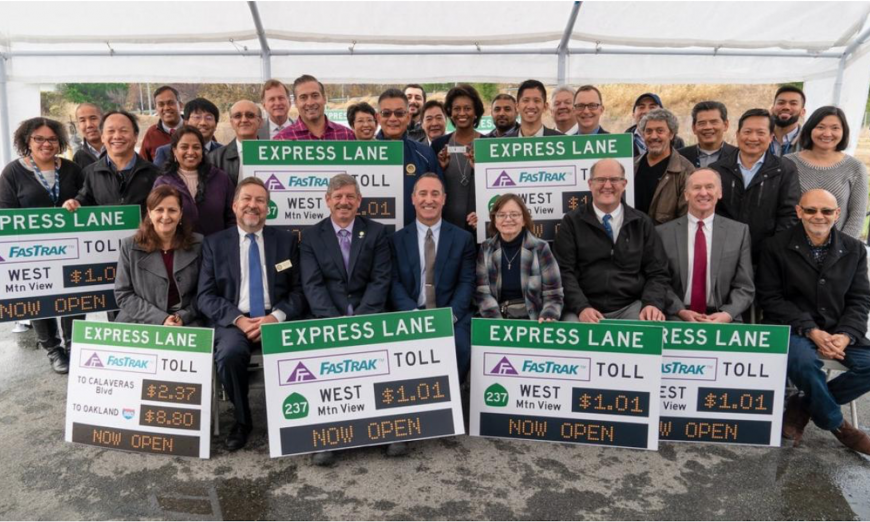On Nov. 15, 2019, Valley Transportation Authority (VTA) opened new Express Lanes on State Route 237. The opening followed a 20-month construction period of a Phase 2 project that’s a continuation of work on the corridor that begin in March 2012. The project’s Phase 1 had added lanes starting at Dixon Landing Road in Milpitas and Phase 2 now extends Express Lanes from North First Street in San Jose to Mathilda Avenue in Sunnyvale, giving commuters seven more miles of Express Lane travel.
“Besides encouraging more people in fewer cars, Express Lanes have three primary objectives, to make the best use of available carpool lane capacity, to provide reliable travel times and options for drivers, and to better manage all lanes to keep traffic moving,” said VTA Board Chair and Santa Clara City Council Member Teresa O’Neill at a celebration event for the lanes opening.
According to Brandi Childress, VTA’s Public Affairs Manager, Phase 1 has been saving commuters between seven and 20 minutes of travel time. While data on Phase 2 is still being collected, reports suggest that the new lanes have also been saving Silicon Valley commuters time.
“We are hearing great things via news reports and man-on-the-street interviews that the time savings is great and that it’s a preferred option when that extra 10-15 minutes saved means making it to a meeting on time or when picking up a child from school or daycare,” Childress commented.
Between Nov. 15 and the end of the 2019, VTA staff found that about 700,000 travelers used the lanes between 5 a.m. and 8 p.m. on weekdays. They calculated that there were about 12,000 Express Lane trips per day with an average toll amount generated per direction at between $5 and $6. Two percent of users have clean-air vehicles and 32 percent are carpoolers using non-clean-air vehicles.
The new Express Lanes come with rules for use. Extended hours have been granted for use of the lanes beginning at 5 a.m. and continuing until 8 p.m.; otherwise, regular traffic is permitted to use the lanes. The most notable rule is that every Express Lane user must have a vehicle equipped with a FasTrak responder device — including all carpoolers, clean-air vehicle drivers and motorcyclists.
“We understand from BATA — the Bay Area Toll Authority who is responsible for toll collection and sending out toll violations — that there are more people than we’d like to see not using the lanes correctly,” said Childress. “For a short grace period, violators will see their penalties waived by signing up for FasTrak and paying the toll amount during the time they used it, but that grace period won’t last forever.”
Express Lane users can sign up for a FasTrak account at bayareafastrak.org to avoid incurring future penalties. Drivers of eligible clean-air vehicles can receive a 50 percent discount on the posted toll but must register with FasTrak to do so.
Current data shows that 44 percent of users are paying the tolls, about half of whom had a FasTrak responder. The responder devices must also be set to indicate the number of passengers in the vehicle for any given trip. Video enforcement is being used to capture those using and not using FasTrak responders.
“We blazed a path in legislation to be able to build and operate these lanes and, along with our neighboring counties, this network of opportunity continues to expand with lanes now operational along 580 and 680,” said VTA General Manager and CEO Nuria Fernandez. “The 880 corridor is not far behind, planned to open next year and more express lanes along US 101 will then follow.”







Updating baths in Krasnogorsk
Restoration of bath coverings in Mytishchi